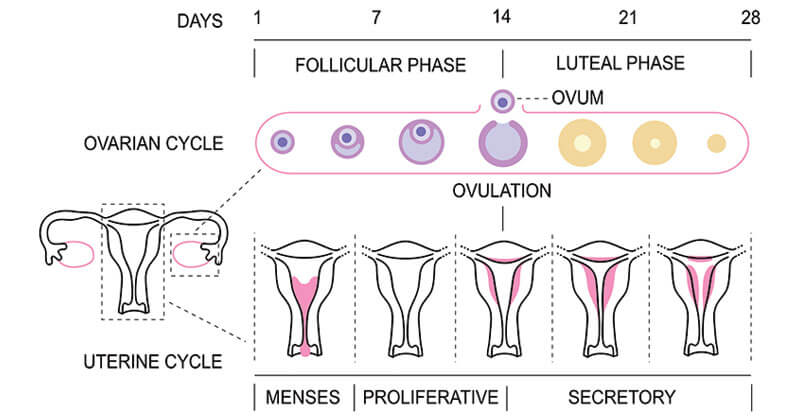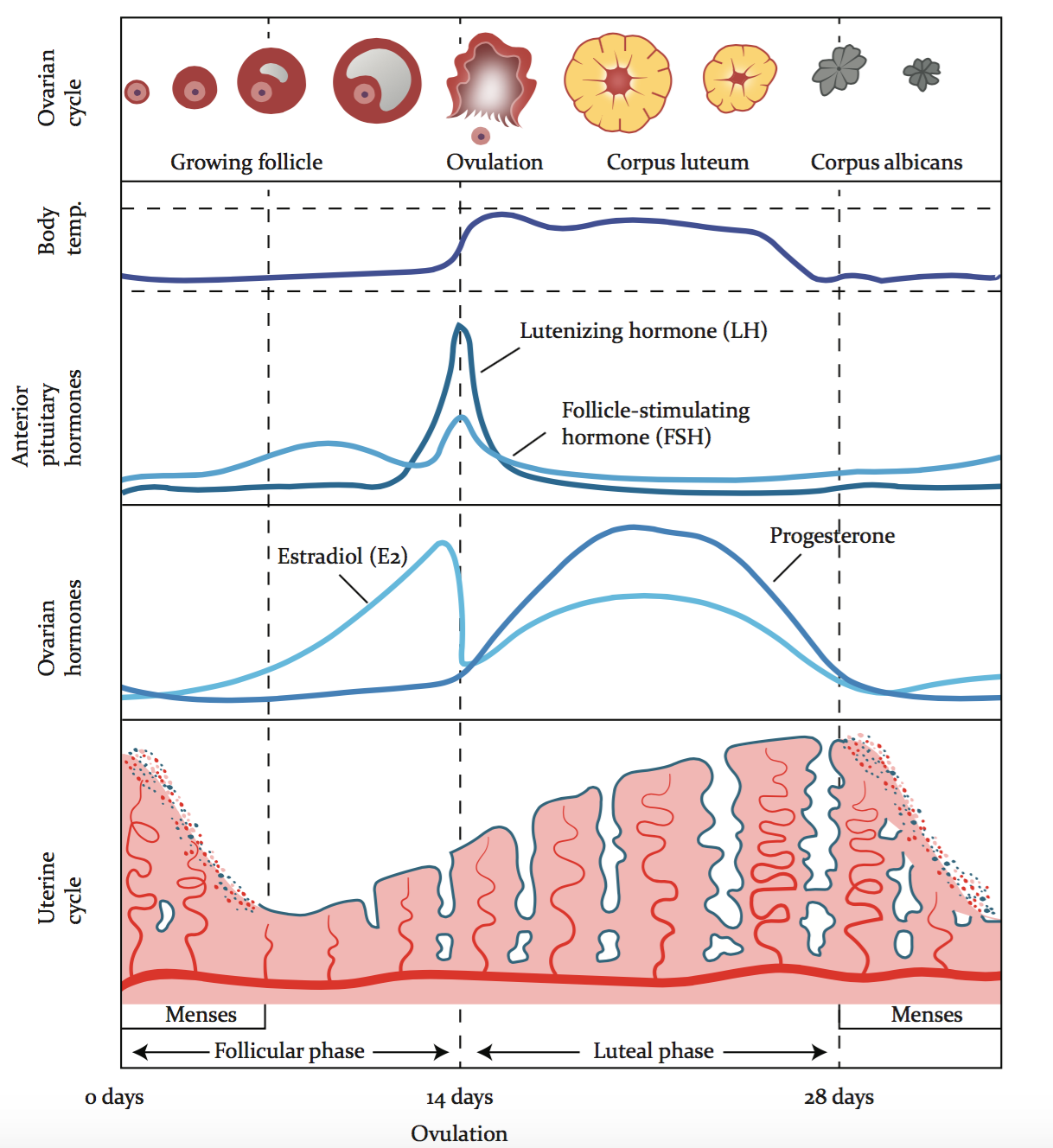Interesting Science Videos
Menstrual Cycle Definition
The menstrual cycle is the process of discharge of blood and other things from the vagina of a woman every month from puberty to menopause excluding pregnancy. It is a natural periodical process that brings changes in the female reproductive system which is responsible for the pregnancy.
- It includes changes that occur in the ovary and the uterine walls simultaneously as a result of changes in the level of hormones in the blood.
- Two significant events occur within the female reproductive organs:
- First is the release of single ovum from one of the ovaries and,
- the second is that the uterine endothelium is prepared for the plantation of a fertilized ovum.
- If the ovum is not fertilized, the lining is released which results in menstruation.
- The duration of the cycles averages about 28 days. However, the period that might differ in different women can range from 20 days to 45 days. The difference in the duration is associated with decreased fertility.
Hormones involved in the menstrual cycle
- The hypothalamus secretes a luteinizing hormone-secreting hormone which stimulates the anterior part of the pituitary to secrete:
-
- Follicle Stimulating Hormone (FSH) causes the maturation of ovarian follicles and stimulates the release of estrogen which is responsible for ovulation.
- Luteinizing Hormone (LH) which triggers ovulation and formation of corpus luteum and release of progesterone.
- Hormones released in the cycle are stimulated by a negative feedback mechanism. The hypothalamus is stimulated when the level of estrogen and progesterone is low in blood and is switched off when their concentration is high.
- The menstrual cycle is described by ovarian and uterine cycles. The ovarian cycle involves the formation and maturation of follicular cells in the ovary, whereas the uterine cycle describes the changes in the endothelial layer of the uterus.

Figure: Menstrual Cycle. Image Source: Wikipedia (Isometrik and Kaldari)
Ovarian Cycle
- The ovarian cycle involves the formation and maturation of follicular cells in the ovary. This cycle is divided into three phases:
Follicular phase
- After puberty, as a result of the release of a large amount of FSH and LH by the pituitary, the ovaries with the follicles start to grow.
- During the first stage, the targeted follicular cells enlarge up to two-fold to three-fold in diameter. These enlarged follicular cells are termed primordial follicles.
- After a few days, the level of FSH surpasses LH which accelerates the growth of 6-10 primary follicles that compete for dominance. Under the influence of FSH, these cells develop layers of granulosa cells as well as express the LH receptors on the granulosa cells.
- The second layer of cells called theca develops around these follicles which can produce other sex hormones like estrogen and progesterone.
- LH from the pituitary and the estrogen within the follicles cause accelerated growth of the primary follicles into vesicular follicles.
- The ovum present inside the follicles develops aggressively increasing in size another threefold to four-fold. After a week or more of growth, one of the follicles starts outgrowing other follicles (a process called atresia). The reason behind the process of atresia is not yet known; however, it is imperative as it prevents more than one child during pregnancy.
- The single follicle further increases in size and forms the mature follicle.
Ovulation phase
- Ovulation in women with regular 28 days of sexual cycles occurs 14 days after the onset of menstruation. Few days before ovulation the follicle starts to swell with a protruding center called the stigma.
- The in-surge of the LH hormone and the release of estrogen from the follicle degrades the cells at the stigma and results in a hole. The secondary oocyte leaves the follicle through the hole and reaches the peritoneal cavity. The secondary oocyte then reaches the fallopian tube through the fimbriae. If there is left-right coordination between the ovaries is not yet known. However, occasionally, both the ovaries release an ovum, which results in the formation of fraternal twins.
- If a sperm fertilizes the oocyte, it develops into a mature ovum. If fertilization doesn’t occur, the secondary oocyte degenerates within the fallopian tube.
Luteal Phase
- The luteal phase is the last phase of the ovarian cycle and it corresponds with the secretory phase of the uterine cycles.
- During the first few hours of ovulation, the remaining follicular cell, including the granulosa and theca develops into lutein cells. This cell then becomes filled with lipid components that give them a yellow appearance. The total mass of the cell is called corpus luteum.
- Corpus luteum produces progesterone that inhibits the release of FSH and LH by the pituitary. Consequently, the concentration of FSH and LH falls over time and the corpus luteum degenerates.
- The falling levels of progesterone then trigger menstruation. The process from the start of ovulation to the withdrawn of progesterone takes around two weeks. Even though the sexual cycle in all women is not the same; the duration of the luteal phase remains more or less the same in all women.
- In the case of a successful pregnancy, the degeneration of corpus luteum is prevented by the release of human chorionic gonadotropin (hCG) from the placenta. Corpus luteum is essential to produce progesterone which maintains the new pregnancy.
Uterine Cycle
- The uterine cycle includes the changes in the endothelial layer of the uterus. It is divided into three phases.
Menstruation
- Menstruation, also called menses, menstrual bleeding, or a period, is the first phase of the uterine cycle. This occurs as a result of the degeneration of corpus luteum which inhibits the release of FSH and LH from the pituitary and thus prevents the proliferation of other follicular cells.
- The menstrual flow often serves as a sign to indicate the women is not pregnant; however, bleeding might also occur during pregnancy due to several reasons.
- The menstrual flow consists of blood from broken capillaries, secretions from endometrial glands, endometrial cells as well as an unfertilized ovum.
- This phase usually lasts about 3-5 days but might range from 2-7 days in some women. On average, 35 milliliters of blood is lost during menstruation, but 10ml to 80ml is considered normal.
- A protein called plasmin is responsible for the prevention of clotting during menstruation.
- Pain in the back, stomach, and upper thigh is common during the first few days of menstruation and severe pain is commonly observed in adolescent girls (67% of women observe severe cramping).
Proliferative Phase
- This is the second phase of uterine cycles where the estrogen causes the proliferation of the endometrial layer in the uterus.
- After the maturation of follicles in the ovary, they cause the release of estrogen which causes the growth of a new layer of endometrium called proliferative endometrium. The endometrium becomes thick with the rapid cell multiplication and increases the mucus-producing cells as well as blood capillaries.
- The estrogen also causes the formation of crypts in the cervix that facilitate the secretion of vaginal discharge.
- This phase ends when ovulation occurs and the level of estrogen declines.
Secretive Phase
- The final phase of the uterine cycle corresponds with the luteal phase of the ovarian cycle, which occurs after ovulation.
- The corpus luteum releases progesterone hormone, which is particularly essential to make the uterus receptive for the implantation of the fertilized ovum. The endometrium becomes oedematous and the secretory glands produce a large amount of watery liquid to assist the passage of spermatozoa.
- If fertilization occurs, the fertilized ovum travels to the uterus through the uterine tube and become embedded.
- However, if fertilization doesn’t occur, menstruation occurs and a new cycle is initiated.
Summary of Menstrual Cycle

Image Source: Vios Fertility Institute
References
- Hall JE and Guyton AC. (2011) Textbook of Medical Physiology. Twelfth Edition. Elsevier Saunders.
- Waugh A and Grant A. (2004) Anatomy and Physiology. Ninth Edition. Churchill Livingstone.
- Marieb EN and Hoehn K. (2013) Human Anatomy and Physiology. Ninth Edition. Pearson Education, Inc.
- https://www.womenshealth.gov/menstrual-cycle/your-menstrual-cycle
- https://www.yourperiod.ca/normal-periods/menstrual-cycle-basics/
- https://www.medicinenet.com/menstruation/article.htm
Internet Sources
- 1% – https://www.earthslab.com/physiology/hormonal-control-reproduction-females-ovarian-menstrual-cycles/
- 1% – https://quizlet.com/20424168/female-reproductive-physiology-flash-cards/
- 1% – https://quizlet.com/198329557/quiz-28-flash-cards/
- 1% – https://en.wikipedia.org/wiki/Ovarian_cycle
- 1% – https://en.wikipedia.org/wiki/Menstrual_Cycle
- 1% – https://en.wikipedia.org/wiki/Fertility_factor_(demography)
- 1% – https://en.wikipedia.org/wiki/Endometrial_cycle
- 1% – https://en.m.wikipedia.org/wiki/Menstrual_cycle
- 1% – https://courses.lumenlearning.com/boundless-ap/chapter/physiology-of-the-female-reproductive-system/
- 1% – https://answersdrive.com/what-maintains-the-corpus-luteum-after-ovulation-4979738
- <1% – https://www.verywellhealth.com/luteal-phase-of-the-menstrual-cycle-3522712
- <1% – https://www.ucsfhealth.org/education/the-menstrual-cycle
- <1% – https://www.thewomens.org.au/health-information/fertility-information/getting-pregnant/ovulation-and-conception/
- <1% – https://www.sciencedirect.com/topics/medicine-and-dentistry/menstruation
- <1% – https://www.researchgate.net/publication/10946646_Rescue_of_the_corpus_luteum_in_human_pregnancy
- <1% – https://www.ncbi.nlm.nih.gov/books/NBK535442/
- <1% – https://www.drmalpani.com/knowledge-center/articles/fsh
- <1% – https://www.britannica.com/science/ovum
- <1% – https://quizlet.com/86769596/46-flash-cards/
- <1% – https://quizlet.com/43921093/physiology-of-female-reproductive-system-flash-cards/
- <1% – https://quizlet.com/23415774/health-science-2-reproductive-system-flash-cards/
- <1% – https://psychology.wikia.org/wiki/Menstrual_cycle
- <1% – https://en.wikipedia.org/wiki/Menstruation
- <1% – https://en.wikipedia.org/wiki/Menstrual_health
- <1% – https://embryology.med.unsw.edu.au/embryology/index.php/Oocyte_Development
- <1% – https://brainly.com/question/8136236
- <1% – http://www.entomoljournal.com/vol2Issue4/pdf/9.1.pdf
- <1% – http://mbbsclub.com/download/2/PHYSIOLOGY/Female%20Reproductive%20System/Female%20Reproductive%20System.pptx

Very nice